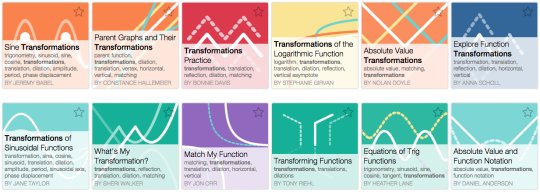by Christopher
If you teach algebra, you probably teach transformations of functions. If you teach transformations of functions and use Desmos, you have probably gotten the idea that this topic and this tool—like chocolate and peanut butter—would go pretty well together.
At present, we have twelve activities in our Activity Builder search pool having to do with transformations of functions.

Each of these is worth looking at—either because you can use it as-is in your classroom, or because you can learn something that applies to building your own activity. Today, I want to look at What’s My Transformation? by Sheri Walker and Meg Craig.
The activity consists of a series of transformation challenges using function notation. The challenges increase in difficulty as the activity proceeds, and there are several reflection questions sprinkled amongst them.
What’s My Transformation? helps to highlight some important things about classrooms and Desmos activities:
1. Teachers need to know whether their students are ready for the activity.
The first two screens discuss function notation and its relationship to transformations, but they don’t serve as anything like a complete introduction. Students will need to have some experience with the meaning of function notation (e.g. f(x) and f(x-2)) before they do this activity.
The overview on the first two screens can signal the necessary prerequisite knowledge to a teacher browsing these lessons. As a classroom teacher I would ask myself, Will my students be able to make sense of this information with what they know right now? and How can I ensure they’ll know it when we do this activity?
2. Thinking about thinking is important.
All of the activities we build (and nearly all that we curate for search) ask students to think about their thinking. We didn’t build a tool for multiple-choice quizzes. We built a tool for activity, and activity requires reflection. This activity asks three such questions:
a. Does this work? This introduces a two-step strategy that may help some students break their work down into smaller pieces.
b. Help Dan out! This asks students to focus on and explain an important difference—a difference they may struggled with themselves.
c. How did you decide? This is a different form of question b. While this is a multiple-choice question, its purpose isn’t to get the right answer, it is to compare the answers and consider why the right one is right. The wrong answers are not distractors, they are ideas that students in any class are likely to try. The wrong answers have similarities, and their differences require attention.
3. Bonus challenges are fun!
The activity ends with two “Bonus challenges”. These turn out to have simple-looking solutions that actually require careful, clever analysis to resolve.
In another post later this week, I’ll share some summaries of the kind of student work we’ve seen in this activity in order to dig deeper into classroom practice and better understand effective use of Activity Builder.
